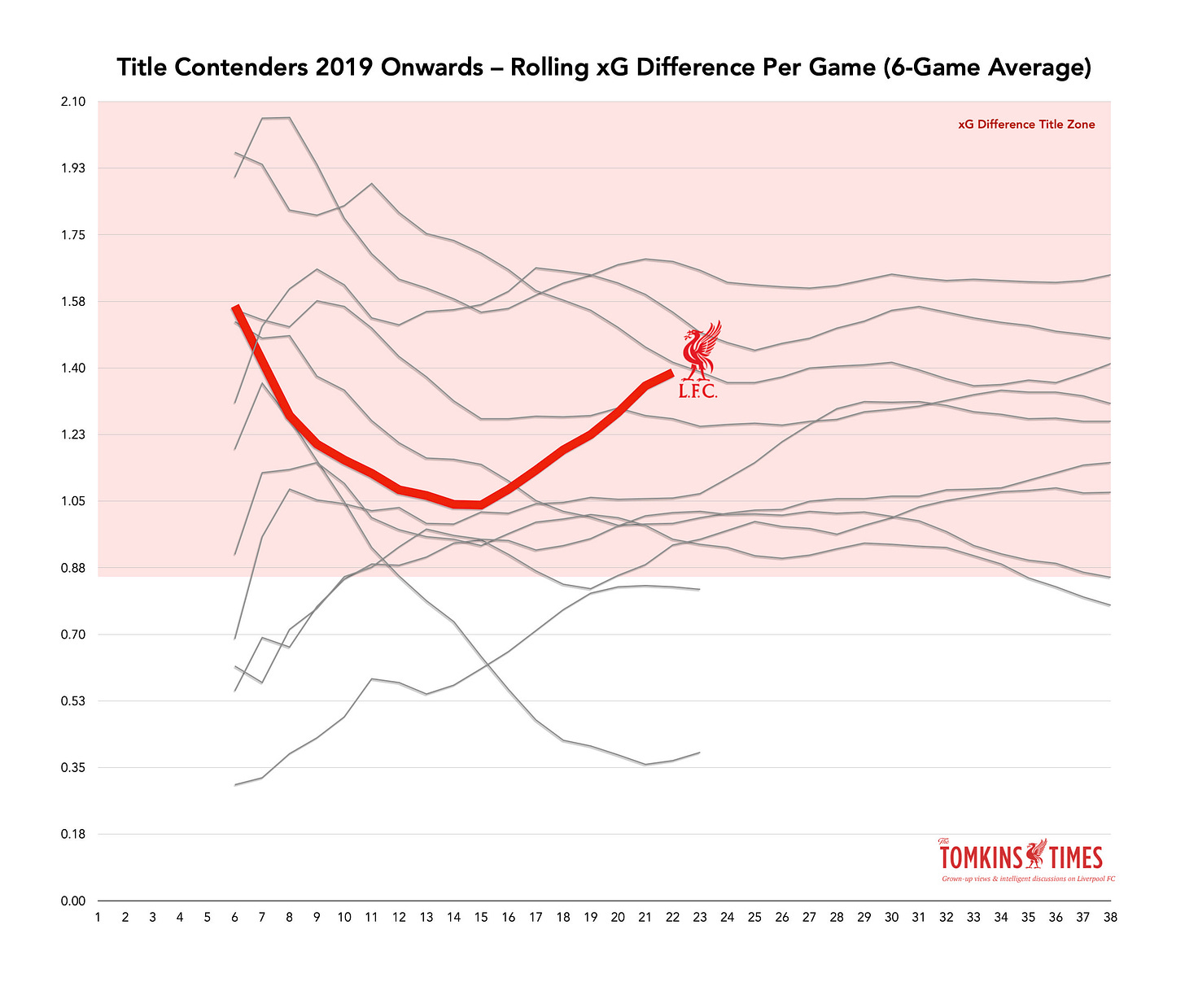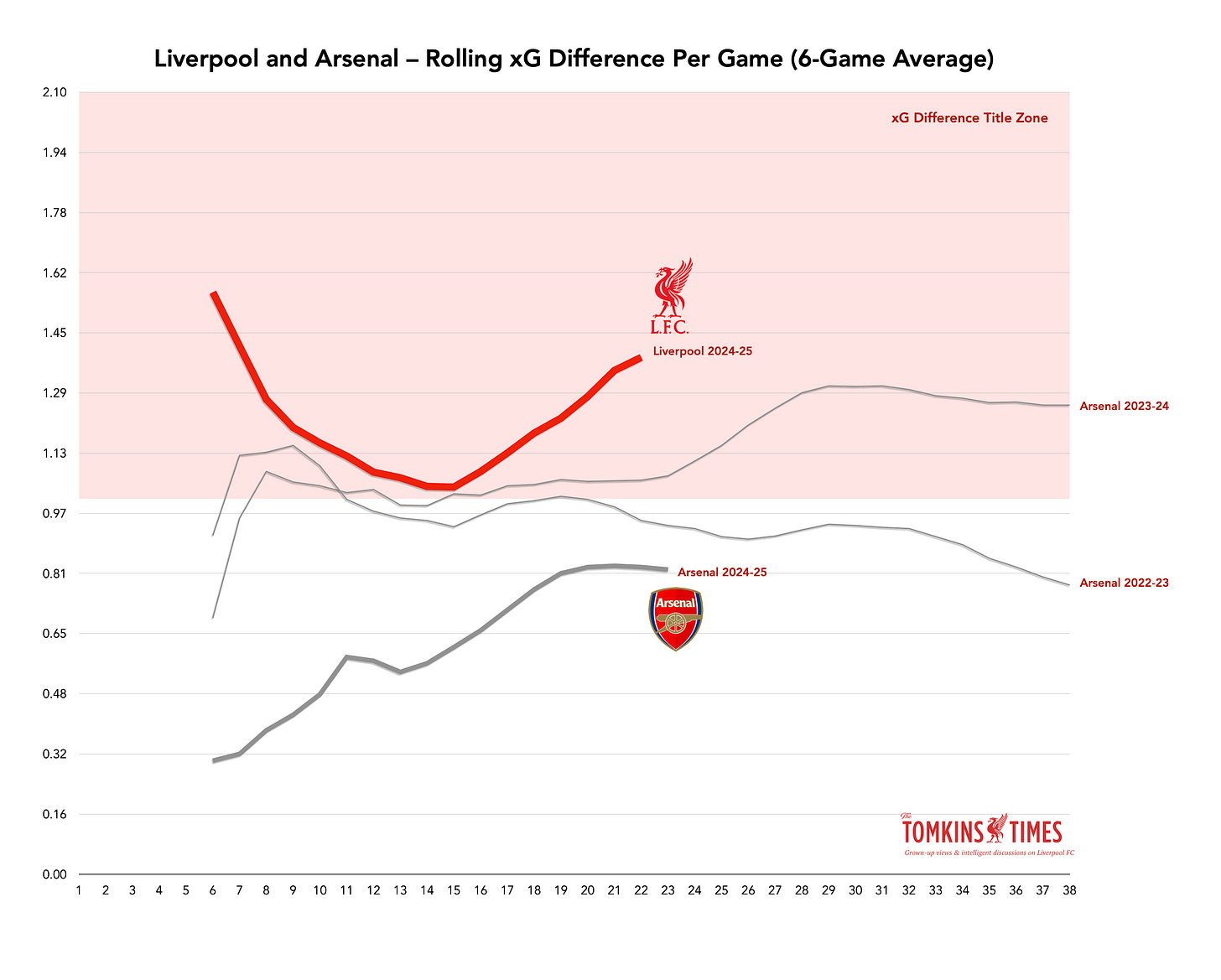This Is Now The Best-Ever* Liverpool Side on xG Difference
* Based on Data since 2017, But Best-Ever Sounds Better
Liverpool are top of the European Club ELO rankings right now, which means they are the best team in the world right now.
And I’m about to argue that, based on an incomplete season but a hefty 29 games in the Premier League and the Champions League, this team is uniquely good; and I do so with the knowledge that things can change, but to highlight a consistency that suggests it may not change.
(The game against PSV Eindhoven may not help the xG Difference, because Arne Slot has left the first team pretty much at home, ahead of the important game at Bournemouth.)
Indeed, if anything, Liverpool’s underlying numbers continue to improve, and are consistently good against the best teams, as well as the worst.
The previous Reds’ peaks in the modern era were in 2020 and 2022, with the latter season being the best in terms of underlying numbers and full-campaign consistency, but 2020 having that insane run of 26 wins and a draw from the first 27 league games.
Indeed, I would argue that 2021/22 was the best team in the club’s history, with a genuine quadruple effort thwarted by the final game of the league season (to lose to a club now facing various charges of gaining an unfair advantage), and beaten by Real Madrid in the Champions League final due to their keeper, basically. Such are the football gods sometimes.
As with Rafa Benítez’s 2009 team that won nothing being better than the 2005 team that won the top prize in Europe, and as with Kenny Dalglish’s 1987/88 ‘only’ winning the league when his first – which Alan Hansen felt was not that great – won the double, it’s incredible how much people swayed by success and not overall quality.
Spurs were a much better team under Mauricio Pochettino than any League Cup success now would provide, even if the mocking of not winning a trophy for two decades must smart. Holland of the 1970s will always be my favourite example of the best team not always winning. They are one of the greatest teams the sport has ever seen. No one goes “ah, but they won nothing”.
As such, xG Difference (per game) is a great way to monitor quality. You can feel it week in, week out, watching Arne Slot’s Liverpool, but it’s nice to see the data reflect an absolute dominance.
If you give up very little in terms of chances, you’ll have a low xG Against; but someone might pop one in the top bins from 30 yards via two deflections and rattling in off both posts. That’s when you say: shit happens.
Similarly, xG is a beautiful way of measuring the mixture of shots and the worth of those shots, rather than just the shot data itself, which could include Joe Gomez’s three shots into the upper echelons of the Kop.
Like any model, it’s not perfect, but if you view it in a balanced way, you can see how good a team is at attacking (if not necessarily scoring) and how good it is at defending (if not necessarily keeping clean sheets).
It’s also helpful to now have timelines, and game-state xG, to see if, as against Ipswich and as at Manchester United earlier in the season (and as against Real Madrid and Bayer Leverkusen), Liverpool only really shipped some xG when the game was won.
If Liverpool are particularly weak and vulnerable in the last minute of a game when 4-0 up, and when most of the the tall guys are off when facing a corner (and one player is being fouled to stop him clearing), and the guy taking the corner should have been sent off minutes earlier, then this should not be keeping anyone awake at night.
“Not very good at 4-0 up” is not a problem.
You also have to look at the context of chances, and as with goal difference, look at a handful of big rack-ups that are not sustained, that may sway the data.
This is what particularly interests me this season: that Liverpool are just consistently better than every team they’ve played, bar two, and those were pretty even (-0.1 and -0.2, both away at strong teams).
And given the Reds were rated as having the 2nd-hardest set of eight Champions League fixtures, you can work those into the sample size, to go from 22 games to 29.
If you want to know how good Liverpool really are, then including games against Real Madrid, Bayer Leverkusen, AC Milan, the team leading the Bundesliga at the time of the match, and two La Liga sides, a French side, and another Serie A side, then that will give you a truer picture.
Indeed, it adds various different styles, to the already broad mix of approaches seen in the Premier League, even if generally, more teams follow a template of passing out from the back now. Liverpool’s Premier League xG is elite; add the Champions League xG Difference and it gets better still; and the last 10 league games, despite some tough fixtures and one played with 10 men, is up around record-breaking xG Difference levels.
Looking at six-game rolling averages in the league, this season’s Reds are on a big upward xG Difference curve, while Arsenal, having improved, are stagnating a bit, and are well below last season’s levels.
**The majority of this article is for paying TTT Main Hub subscribers only.**
*I take a look at the historical success rates of xG Difference, as well as game-state, and which Liverpool players perform well, and less-well, in terms of xG conversion.*
Keep reading with a 7-day free trial
Subscribe to The Tomkins Times - Main Hub to keep reading this post and get 7 days of free access to the full post archives.





